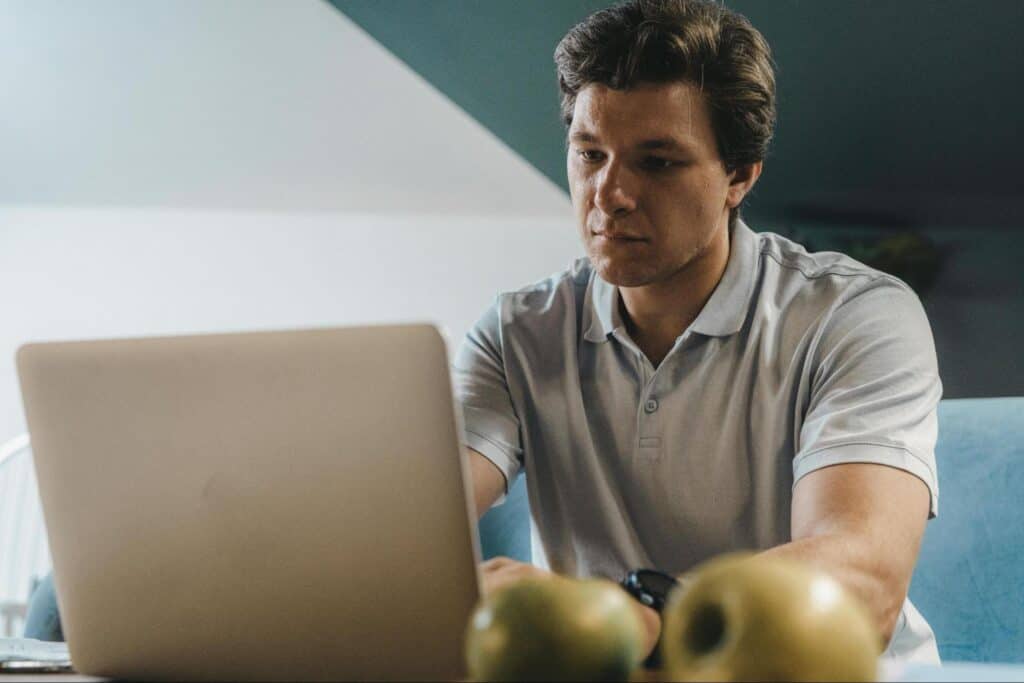Wouldn’t it be nice to have a chatbot for your business? Something that runs round-the-clock on your website so you don’t miss possible customers in the wee hours of the night?
A 2025 report found that night-owl shoppers generate the highest revenue despite making up only a small portion of total browsing, showing how valuable late-night traffic can be.
Well, it’s time to learn how to train AI. With the right training, your personalized AI model will be able to analyze customer data, predict what you need, and give fast and accurate responses.
But this isn’t just for businesses to take advantage of. AI has made an impact on jobs across the board, using machine learning to streamline tasks and improve decision-making with reliable data.
Whether you’re a business owner looking to improve your operations or a researcher who wants to push the limits of today’s tech, knowing how AI works is definitely beneficial.
Here’s our guide on how to train an AI model to make it your powerful asset.
Let’s dive in!
Key Takeaways
- Training an AI model involves feeding it large, high-quality datasets so it can learn patterns, make predictions, and improve accuracy over time.
- The process includes several key stages: data collection, cleaning, labeling, augmentation, splitting, balancing, privacy protection, tuning, evaluation, and deployment.
- Clean, unbiased, and secure data are critical to ensure fair and reliable AI models that can perform accurately in real-world applications.
- Continuous monitoring after deployment prevents data drift and performance decline, keeping your model efficient and trustworthy.
- Tools like Undetectable AI can refine and humanize AI-generated content throughout the training process, ensuring outputs are natural, ethical, and effective for real-world use.
What is AI Training, and Why Does It Matter?
AI training is just what it sounds like—the process of training a machine learning model. With your help, it can learn to recognize patterns, make predictions, or perform specific tasks.
The training involves feeding the AI system a large amount of relevant data. The model analyzes this data and learns from it. We can then expect its performance to improve over time.
The better the quality of data that’s used during training, the more accurate and effective the AI model will be.


Never Worry About AI Detecting Your Texts Again. Undetectable AI Can Help You:
- Make your AI assisted writing appear human-like.
- Bypass all major AI detection tools with just one click.
- Use AI safely and confidently in school and work.
But why does training your AI model matter? Here are some reasons:
- Customization: You can tailor the AI model to meet the unique requirements of your business or project.
- Improved Accuracy: A well-trained model can enhance forecast accuracy for better decision-making.
- Cost-Effectiveness: Automating processes with AI can reduce operational costs and increase productivity.
- Increased Efficiency: AI can read a lot of data really quickly, so this means that your operations can be much more efficient.
- Scalability: As your business grows, your AI model can also be updated and trained with new data to continue delivering good results.
So, while AI might sound complicated at first, it’s actually a good thing. This impressive tech does all the repetitive work so we can focus on more creative and strategic tasks.
It’s even argued that technological unemployment itself is a myth since we’ve always made progress throughout history.
Just as the Industrial Revolution opened up new job opportunities, it’s fair to think that we expect AI to do the same.

The AI Training Process Step-by-Step
Learning AI skills has become quite an advantage. It’s being used more and more across industries, so knowing how it works can give you an edge in your field.
Knowing how to train an AI model allows you to control its functions. Let’s get into the in-depth AI training process.
Step 1: Data Collection
The foundation of AI training relies on its data. The quality of the data you collect directly impacts how accurate and effective your AI model is going to be.
When training a model, you’ll need to be able to gather relevant data based on your project’s goals, regardless of whether they’re images, text, audio, or other formats.

To ensure the authenticity of image datasets, tools like AI Image Detector can help distinguish between real and AI-generated visuals, improving the reliability of your model.
How you collect data also depends on the scope of your project.
Different data collection methods can be used to suit various tasks:
- Manual Data Entry: Collecting data manually through surveys, forms, or direct observation.
- Web Scraping: Extracting data from websites using tools like a web scraping API. Many developers pair scraping tools with the best datacenter proxies to avoid blocks and keep requests fast and cost-efficient.
- APIs: Using Application Programming Interfaces to gather data from external sources.
- Data Repositories: Making use of pre-existing datasets that are already available in public databases.
Just be aware that data collection can come with its own challenges, like having incomplete data, receiving duplicate entries, or even irrelevant information.
If you’re considering web scraping as part of your data pipeline, it’s worth exploring the best web scraping APIs available now — 2025 tools that help make data gathering more scalable and reliable. Having high-quality data is important for the success of your AI model.
Having high-quality data is important for the success of your AI model.
Step 2: Data Cleaning and Preprocessing
Once you’ve collected your relevant data, you can proceed to clean and preprocess it.
Data cleaning removes unnecessary information and deals with errors, duplicates, and missing values. You need this step so that your data is accurate, reliable, and ready for analysis.
Meanwhile, preprocessing transforms cleaned data to be compatible with the AI algorithm.
Preprocessed data leads to better model performance, higher accuracy, and more meaningful results.
Poorly prepared data can introduce noise and bias, which results in inaccurate or unreliable conclusions. Cleaning and preprocessing your data helps models perform at their best.
Step 3: Data Labeling
In this next step, the data must be labeled so the AI model can understand and learn from it.
Data labeling is the process that identifies and tags raw data with relevant labels that make the data machine-readable.
You can do this via manual vs. automated labeling:
- Manual Labeling: We (humans) label the data. This method is more time-consuming but can be very reliable for complex tasks.
- Automated Labeling: AI models are used to label data based on the patterns they learned. When the models are confident, they can label data automatically. If they’re uncertain, they pass the data to humans for labeling.
The goal here is to create a labeled dataset known as “ground truth,” which serves as the standard for training the AI model.
Step 4: Data Augmentation
Data augmentation expands your dataset by making small changes—like rotating or flipping images—to generate new data from existing data. It helps create diverse datasets for AI model training.
By artificially increasing your dataset’s size and variety, data augmentation can make the AI model more robust.
This lets your AI model handle real-world scenarios more effectively, even when the actual data is limited.
Step 5: Splitting the Dataset
Splitting your dataset is essential for evaluating how accurate the AI model is. Typically, you’ll divide your data into training and test sets.
The training set teaches the model, while the test set assesses its performance.
Sometimes, there’s also a third set called the validation set. This is added to fine-tune the model during training.
Different ways to split the dataset prevent overfitting and make sure that the model can handle new, unseen data with ease.
Step 6: Data Balancing and Bias Mitigation
Avoiding bias is crucial when training an AI model. This is because AI bias can lead to unfair decisions that negatively affect certain groups of people.
Data balancing ensures that your dataset represents different groups fairly, and this can prevent your model from favoring one outcome over another.
To mitigate AI bias, you can use techniques like:
- Oversampling: Increasing examples from underrepresented groups.
- Undersampling: Reducing examples from overrepresented groups.
- Data Synthesis: Generating artificial data for minority groups.
Balancing your data helps create a fairer AI model that’s able to deliver unbiased results, making it more reliable.
Step 7: Data Privacy and Security
More than eight out of ten users believe that how a company handles their personal data also reflects how they treat clients.
Data privacy and security builds trust by keeping personal information safe from prying eyes.
With so much sensitive data out there, protecting it from breaches and misuse is more important than ever.
When businesses take privacy seriously, it shows that they care.
Make sure the data you use is encrypted so that personal details are hidden, and always follow strict security regulations to protect it from unauthorized access.
By doing this, you ensure that the AI training process is done responsibly.
Step 8: Hyperparameter Tuning
Hyperparameter tuning is the process of adjusting the settings that control your AI model’s structure and behavior.
Examples of hyperparameters include learning rates, batch sizes, and the number of layers in a neural network.
Manual tuning can give you better insight into how these settings affect the model, but it’s time-consuming. Automated methods like grid search can speed up the process.
The goal is to find the best combination of hyperparameters to optimize your model’s performance without overfitting or underfitting.
Step 9: Model Evaluation and Validation
Once your model has been trained, you can finally evaluate how well it will perform. Model evaluation measures the model’s ability to generalize and make accurate predictions based on new data.
This can be typically done using the test set, and you can measure the performance with metrics like accuracy and precision.
If you’re concerned about bias, you can further split the test data into groups, such as by gender or geographical location, so that the model performance stays fair across all groups.
You can also use reliable AI tools like Undetectable AI in the training process to refine and humanize AI-generated content.

Undetectable can make sure that the content generated reads naturally and bypasses the toughest AI detection tools, making your model even more effective in real-world applications.
Step 10: Deployment and Monitoring
Training your model is only half the job. Deployment integrates the model into existing systems where users or applications can access it. This is the real test of your AI model.
You’ll need to monitor your model post-deployment to ensure that it continues to deliver value. Issues like data drift can impact its performance over time.
Constant monitoring lets you catch these problems early on and make the necessary adjustments.
Tools that highlight key features of AI-SPM (AI-based Strategic Performance Management) help track system health, optimize decision-making, and align model outputs with evolving business goals.
Undetectable AI can assist here as well by serving as your continuous AI-monitoring tool – even after deployment.
By doing this, your content stays high-quality and safe from AI detectors in real-world settings, maintaining your model’s effectiveness.

The Future of AI Training
It’s exciting to see the possibilities of AI. As technology evolves even further, we can expect AI training methods to become more sophisticated.
Here’s what we can see the future of AI training holds:
- Automated Data Collection: AI will be able to handle more of the data gathering, reducing the time and effort required.
- Ethical AI Development: Emphasis on fairness and bias mitigation will become a standard in AI training.
- Real-Time Learning: AI models will learn and adapt on the go, making them more responsive to new information.
- Enhanced Personalization: AI will be better at tailoring experiences based on individual needs.
The future is bright for AI. It’s already being used in everyday life. While it can feel overwhelming, the good news is that these advancements will make AI more powerful and accessible.
Businesses seeking to stay ahead in this evolving landscape can greatly benefit from professional AI development services.
These services focus on improving how AI learns, paving the way for groundbreaking applications and possibilities.
Common Challenges When Training AI (And How to Overcome Them)
Training an AI model isn’t always smooth sailing.
Even with the right steps in place, beginners often face issues that affect accuracy, speed, and reliability.
One of the most common challenges is dealing with low-quality or inconsistent data, which can lead to inaccurate predictions.
Some models also overfit, meaning they perform well during training but fail when exposed to new information. Hardware limitations can slow down training, especially for resource-heavy models.
Bias in datasets is another major concern, often causing unfair or skewed outputs. The best way to handle these issues is with clean, balanced data, regular validation, and ongoing adjustments after deployment.
Tools like Undetectable AI can also help refine AI-generated content during training so your model learns from more natural, human-quality examples.
Try the Undetectable AI Widget now! It’s incredibly simple—just copy your text and click the button to humanize it.
Conclusion
Learning how to train AI might seem complex, but breaking it down really shows that it’s quite manageable – and the payoff is undeniable.
Each phase you take carefully can play a crucial role in shaping how powerful and effective your AI model can be.
Remember to integrate Undetectable AI into your training process so that it can improve your model’s performance (especially in the later stages).
Being able to refine your AI-generated content to bypass detection tools and read more naturally will make it work better in real-world applications, especially for content creation.
